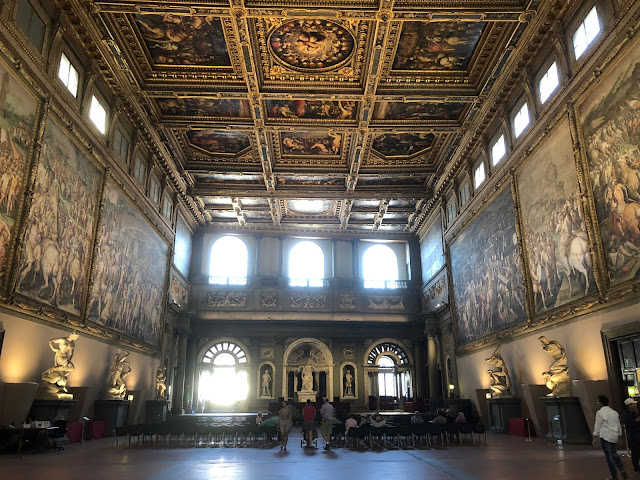【フィレンツェ】ヴェッキオ宮殿 五百人広間の物語 Firenze - Palazzo Vecchio : Salone dei Cinquecento
チケットを買って、長い行列に並び、ようやくヴェッキオ宮の中に入ることができた。
見学用のコースを辿ってまずは壮麗な階段を2階に上がる。そこには、巨大な五百人広間がある。
フィレンツェが共和国だった時代には、ここに多くの市民が集まり、フィレンツェの運命に関わる重要な政治的な決断が行われてきた。
天井も、両側の壁にも、巨大な絵が描かれている。これらを描いたのは、『芸術家列伝』を書いたことで有名なヴァザーリとその工房の画家たちだ。
しかし、あまりにもよく知られている話だが、かつてこの場所には、レオナルド・ダ・ヴィンチとミケランジェロというルネサンスを代表する二人の芸術家の作品が向かい合って描かれるはずだった。
I bought a ticket, lined up in a long line, and finally got inside the Palazzo Vecchio.
Follow the tour course and go up the magnificent stairs to the second floor. There is a huge hall for 500 people.
During the time when Florence was a republic, many citizens gathered here to make important political decisions regarding the fate of Florence.
Huge paintings are drawn on the ceiling and on the walls on both sides. These were painted by Vasari, who is famous for writing "Lives of the Most Excellent Painters, Sculptors, and Architects" .
But, as is well known, the place was once supposed to feature the works of two Renaissance artists, Leonardo da Vinci and Michelangelo.
五百人広間の正面に向かって、左側にはピサとの戦いの場面が、右側にはシエナとの戦いの場面が描かれている。
左側には、もともとはミケランジェロのカッシナの戦いの絵が、右側にはダ・ヴィンチのアンギアーリの戦いの絵が描かれていた。
Facing the front of the 500-person hall, the scene of the battle with Pisa is drawn on the left side, and the scene of the battle with Siena is drawn on the right side.
On the left was originally a picture of Michelangelo's Battle of Cascina, and on the right was a picture of Da Vinci's Battle of Anghiari.
かつての巨匠の作品は、すでに失われているが、多くの画家たちによる模写が残されていて、どんなシーンが描かれていたのかは、よくわかっている。
ダ・ヴィンチの描いたアンギアーリの戦いとは、1440年にフィレンツェ軍がアンギアーリの地でミラノ軍に勝利を収めた戦いのこと。
そのフレスコ画は騎馬戦のシーンで、軍旗を巡って、騎馬に跨った戦士同志が戦い、あるいは馬から落ちて地上で入り乱れて戦いを繰り広げる、躍動的なシーンが描かれていたようだ。
The work of the former master has already been lost, but many painters have copied it, and it is well known what kind of scene was drawn.
The Battle of Anghiari depicted by Da Vinci is the battle in which the Florentine army defeated the Milan army in the land of Anghiari in 1440.
The fresco is a scene of a horse fight, and it seems that a dynamic scene was drawn in which warriors straddling the horse fight over the military flag, or fall from the horse and fight in a mess on the ground.
一方のミケランジェロが描いたカッシナの戦いは、1364年にカッシナの地でフィレンツェ軍がピサとの戦いに勝利を収めた戦い。
残された模写には、戦いに向かうために急いで武具を身につけようとしている兵士たちの裸の姿が描かれている。
裸の人間の姿を表現するということは、ミケランジェロにとっては生涯を通じて常に追い求めていたテーマであったのだろう。
The Battle of Cascina, depicted by Michelangelo, was a battle in which the Florentine army won the battle with Pisa in the land of Cascina in 1364.
The remaining replica depicts the naked figures of soldiers rushing to wear armor to head for battle.
Representing a naked human figure would have been a theme that Michelangelo had always pursued throughout his life.
ダ・ヴィンチの作品は、通常のフレスコ画の描き方とは違った方法で描かれたせいか、制作を始めた直後からすでに劣化が始まった。
ダ・ヴィンチは、結局その絵を完成させることなく、制作を放棄してしまった。
一方のミケランジェロの方も、制作には取りかかったものの、教皇ユリウス2世からローマに招聘されて、フィレンツェを去ってしまい、そのフレスコ画はついに描かれることはなかった。
Da Vinci's work had already begun to deteriorate immediately after the production began, probably because it was drawn in a different way from the usual frescoes.
Da Vinci eventually abandoned his production without completing the painting.
Michelangelo, on the other hand, started production, but was invited by Pope Julius II to Rome and left Florence, and the fresco was never drawn.
このヴェッキオ宮には、ダ・ヴィンチのアンギアーリの戦いを、16世紀頃に模写した作品が展示されている。
この壁画の模写には、タヴォラ・ドーリアと呼ばれる有名な模写作品があり、この2つの作品はかつて2015年に日本で行われた展覧会に出品された。
その展覧会では、この絵は、実に恭しい雰囲気で展示されていたが、ヴェッキオ宮では、特に何の説明プレートもなく、 無造作に壁に架けられていた。
最近の調査では、ヴァザーリの絵の後ろには、ダ・ヴィンチの未完のフレスコ画がそのまま残されているという。
果たして、その姿を眼にすることができる日が訪れるのだろうか?
At this Palazzo Vecchio, works that copy the Battle of Anghiari in Da Vinci around the 16th century are exhibited.
This mural copy includes a famous copy called Tavola Doria, which was once exhibited at an exhibition in Japan in 2015.
At the exhibition, the painting was exhibited in a very reverent atmosphere, but at Palazzo Vecchio, it was casually hung on the wall without any explanation plate.
A recent study found that behind Vasari's paintings, Da Vinci's unfinished frescoes were left untouched.
Will the day come when we can see it?
(Translated by Google Translate)








コメント
コメントを投稿